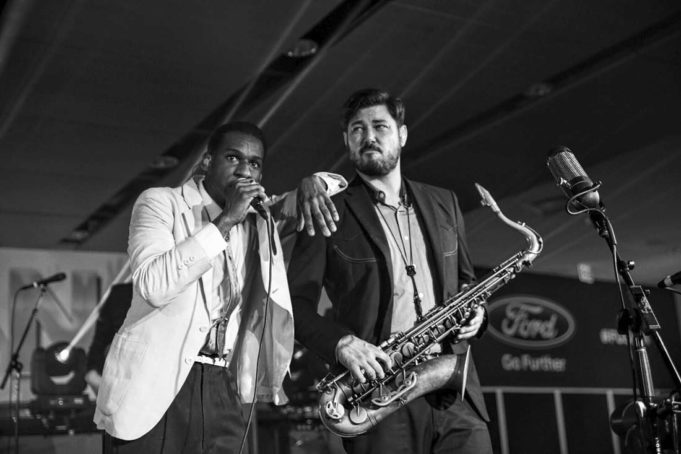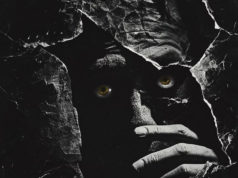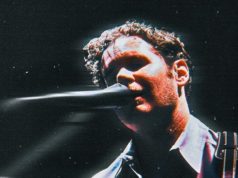The Tarrant County College south campus’ jazz band was recently performing at the Live Oak. The music hall was packed. TCC jazz director Rick Stitzel deftly guided his big band through popular standards, newer works, and a surprising jazzed-up arrangement of Oasis’ “Wonderwall.” As a band member put his horn down, took the mic, and sang an arrangement of a Michael Jackson tune, Jeff Dazey, baritone sax in hand, quietly stepped out from behind the curtain to fill the vacated seat. Stitzel warmly welcomed his former protégé to the stage.
“Dazey agreed to play with us on short notice,” the band director said. “He’s in between tours performing with Leon Bridges.”
The audience, well aware of that fact, gave a rousing applause to the 35-year-old, who had been a member of the TCC jazz band for more than seven years. Though he is busy touring the country as Bridges’ sax man, Dazey never sits still for long when he’s back home –– he makes it a point to drop in on various open-mic nights and play live with friends. His schedule won’t be opening up any time soon. He and Bridges are set to record a new album at Niles City Sound studio in November.
The impossibly nice, always affable Dazey was one of a handful of local talents to join Bridges’ rise to stardom and acclaim. But Dazey wasn’t just some label hotshot who came in and tagged along for the ride. He’s been playing area stages for 17 years, earning his stripes in various bands, recording projects, and teaching gigs.
Dazey credits the generation of Fort Worth musicians before him, like multi-instrumentalist Joey Carter, Stitzel, sax impresario Johnny Reno, and others, with giving him the opportunities he now enjoys. And he hopes to do the same for the next crop of young musos.
“There’s a huge drop off in the number of kids who stick with saxophone after middle school,” he said. “That’s part of why I still reach out to schools and do educational clinics. With the recent success I’ve had, I want to use it for some good. It’s our generation’s responsibility.”
Music has cast a spell over the horn player for as long as he can remember. At age 6, Dazey would dart to his Casio keyboard after returning from a movie to plunk out the themes he heard. His love affair with saxophone began at age 4 while listening to the soundtrack to Back to the Future featuring Etta James’ “The Wallflower (Dance with me Henry).” His affinity for mid-20th century music has remained a strong influence on his playing.
“When that sax solo comes in, that first note just fascinated me,” Dazey recalled. “You could say I gave it all up for one note. And that note had a growl.”
In the sixth grade in San Antonio, he jumped at the chance to play tenor sax in the school’s band. Dazey’s first professional gig came one year before he settled in Fort Worth at age 16. Just before the move, a friend invited the young horn player to sit in at a blues gig.
“I came home reeking of cigarette smoke,” Dazey recalled. “My parents were horrified. I was excited. I wasn’t playing in a high school auditorium. That was a different audience –– the type of people I’ve hung out with ever since.”
That experience led him to the TCU School of Music program in fall of 1999, where he met the then-18-year-old Jordan Richardson, now a Grammy-winning musician, studio engineer, and the main man in indie-rockers Son of Stan.
“We bonded over a love of jazz,” Richardson recalled. “The big band was a close-knit family.”
Looking back, Dazey has mixed feelings about his time at the private university. While TCU has a full-time saxophone professor now, back then, the young musician was often left with less than inspirational instructors who pushed him to mimic John Coltrane. Dazey ended up with two Fs in his saxophone classes. But his time as a Horned Frog wasn’t all bad. In 2000, he toured Europe with the TCU Jazz Ensemble.
“We were able to see and experience a lot of things then that we get to do in our professions now,” Richardson said. “It lit the fire inside of us. I know for sure it did for” Dazey.
It was in the early aughts in TCU bars and clubs like The Aardvark, The Moon Bar, and Halo Lounge that Dazey befriended the crop of young musos who would redefine Fort Worth’s music scene in the coming years: Sam Anderson, Andrew Skates, Josh Weathers, and many others.
Almost every night, Dazey, Richardson, and a tight group of friends were out performing.
Around that time, during a five-year stint with a now-defunct jazz fusion/funk group Villain Vanguard, Dazey first met crooning star Weathers. The multifaceted vocalist and guitarist periodically opened for the funky group. Dazey would go on to play in Weathers’ horn section for several years.
“Josh Weathers was incredible,” Dazey said. “He’s one of those musicians who can turn his influences into his own thing.”
The formative time also connected the aspiring horn player with jazz legends, including former Miles Davis and Jaco Pastorius keyboardist Bernard Wright.
“At the time, I thought he was the greatest keyboardist I’d ever heard,” Dazey recalled. “He told me stories about working with Davis and Pastorius. He even taught me things on piano.”
After Villain Vanguard split in 2008, the saxophonist underwent a renaissance of sorts, broadening his boundaries by performing with dozens of local and regional bands as a freelance musician, including a stint with ’70s-era stoner rock super group EPIC RUINS. Dazey was heeding advice from his mentor Stitzel, who advised his pupils to be as musically diverse as possible and put in ample time practicing.
The years of musical explorations and collaborations led to a chance meeting with the then-little-known 22-year-old Bridges in 2012. Dazey was heading jazz-fusion group Gunga Galunga at the now-shuttered Wherehouse where Bridges stopped by at an open-mic night.
“The second band to go on had [Bridges] in it,” Dazey said. “After listening to one song, I knew this was up my alley … I went to play two songs. We connected on stage and things have stayed that way through many forms of instrumentation, including the studio band we use on stage today.”
After Bridges signed a deal with Columbia Records in December 2014, Bridges and his bandmates experienced a meteoric rise with tours of Europe and performances on Saturday Night Live and The Late Show, among others. The commercial success of Bridges’ retro R&B sound has admittedly put pressure on the band.
“I understand there will be critics no matter what we do,” Dazey said.
Bridges said Dazey gives his band a connection to the past without being cliché.
“I wanted to avoid the common ‘soul’ thing by not having a three-piece horn section,” he said. “People automatically identify that sound with Motown, Stax, or Daptone records. That’s not who we are.”
Dazey is a great musician with a “pure heart” who never asked for money when times were tough, he added.
Part of Dazey’s success comes from the dwindling number of sax players that stay active in the music scene. Admittedly, it’s made him a go-to musician for shows and recording sessions, but it’s also a reminder that he has an obligation to mentor young saxophonists and remind them that music can be a viable profession.
“I didn’t really have a backup plan,” Dazey said, referring to his music career. “It was all or bust. I feel very fortunate to have spent my entire music career in this city. I got to play with all these bands. I feel like I had the best seat in the house.”












